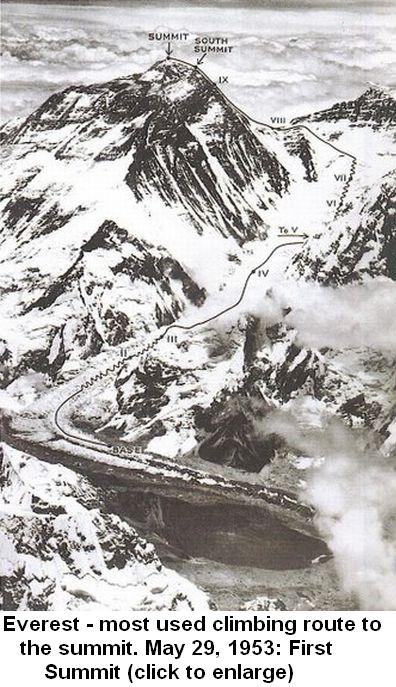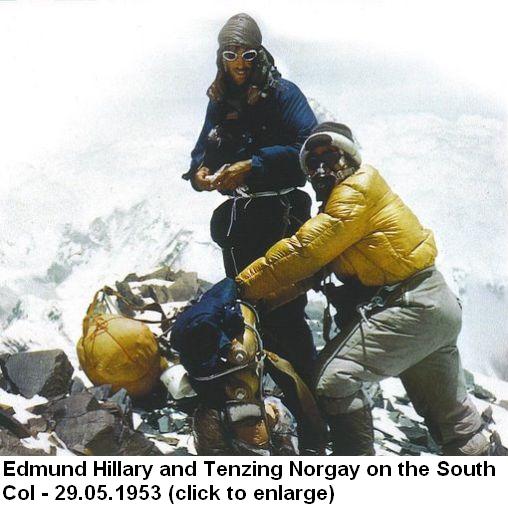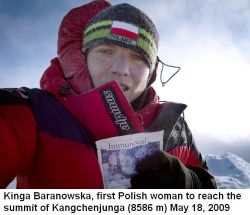Mt. Everest has two main climbing routes, the southeast ridge from Nepal and the northeast ridge from Tibet, as well as many other less frequently climbed routes /watch the next posts/.
South Col - South East Ridge Route - part 1.
Of the two main routes, the southeast ridge is technically easier and is the more frequently-used route. It was the route used by Edmund Hillary and Tenzing Norgay in 1953 / photo on the right /. With supplemental oxygen, Edmund Hillary of New Zealand and Sherpa Tenzing Norgay made their way to the top via the South Col, that became the most used climbing route to the summit. May 29, 1953: First Summit !!!!
In a present time the ascent via the southeast ridge begins with a trek to Base Camp at 5,380 m (17,600 ft) on the south side of Everest in Nepal. Expeditions usually fly into Lukla (2,860 m) from Kathmandu and pass through Namche Bazaar. Climbers then hike to Base Camp, which usually takes six to eight days, allowing for proper altitude acclimatization in order to prevent altitude sickness. Climbing equipment and supplies are carried by yaks, dzopkyos (yak hybrids) and human porters to Base Camp on the Khumbu Glacier. When Hillary and Tenzing climbed Everest in 1953, they started from Kathmandu Valley, as there were no roads further east at that time.
Climbers will spend a couple of weeks in Base Camp, acclimatizing to the altitude. During that time, Sherpas and some expedition climbers will set up ropes and ladders in the treacherous Khumbu Icefall. Seracs, crevasses and shifting blocks of ice make the icefall one of the most dangerous sections of the route. Many climbers and Sherpas have been killed in this section. To reduce the hazard, climbers will usually begin their ascent well before dawn when the freezing temperatures glue ice blocks in place. Above the icefall is Camp I at 6,065 m (19,900 ft).
From Camp I, climbers make their way up the Western Cwm to the base of the Lhotse face, where Camp II or Advanced Base Camp (ABC) is established at 6,500 m (21,300 ft). The Western Cwm is a relatively flat, gently rising glacial valley, marked by huge lateral crevasses in the centre which prevent direct access to the upper reaches of the Cwm. Climbers are forced to cross on the far right near the base of Nuptse to a small passageway known as the "Nuptse corner". The Western Cwm is also called the "Valley of Silence" as the topography of the area generally cuts off wind from the climbing route. The high altitude and a clear, windless day can make the Western Cwm unbearably hot for climbers.
Everest : South Col - South East Ridge Route.
From ABC, climbers ascend the Lhotse face on fixed ropes up to Camp III, located on a small ledge at 7,470 m (24,500 ft). From there, it is another 500 metres to Camp IV on the South Col at 7,920 m (26,000 ft). From Camp III to Camp IV, climbers are faced with two additional challenges: The Geneva Spur and The Yellow Band. The Geneva Spur is an anvil shaped rib of black rock named by a 1952 Swiss expedition. Fixed ropes assist climbers in scrambling over this snow covered rock band. The Yellow Band is a section of interlayered marble, phyllite, and semischist which also requires about 100 metres of rope for traversing it.
On the South Col, climbers enter the death zone. / photo on the right - Edmund Hillary and Tenzing Norgay on the South Col/ 
Climbers typically only have a maximum of two or three days they can endure at this altitude for making summit bids. Clear weather and low winds are critical factors in deciding whether to make a summit attempt. If weather does not cooperate within these short few days, climbers are forced to descend, many all the way back down to Base Camp.
From Camp IV, climbers will begin their summit push around midnight with hop es of reaching the summit (still another 1,000 metres above) within 10 to 12 hours. Climbers will first reach "The Balcony" at 8,400 m (27,700 ft), a small platform where they can rest and gaze at peaks to the south and east in the early dawn light. Continuing up the ridge, climbers are then faced with a series of imposing rock steps which usually forces them to the east into waist deep snow, a serious avalanche hazard. At 8,750 m (28,700 ft), a small table-sized dome of ice and snow marks the South Summit.
From the South Summit, climbers follow the knife-edge southeast ridge along what is known as the "Cornice traverse" where snow clings to intermittent rock. This is the most exposed section of the climb as a misstep to the left would send one 2,400 m (8,000 ft) down the southwest face while to the immediate right is the 3,050 m (10,000 ft) Kangshung face.
At the end of this traverse is an imposing 12 m (40 ft) rock wall called the "Hillary Step" at 8,760 m (28,750 ft). 
Hillary and Tenzing were the first climbers to ascend this step and they did it with primitive ice climbing equipment and without fixed ropes. Nowadays, climbers will ascend this step using fixed ropes previously set up by Sherpas. Once above the step, it is a comparatively easy climb to the top on moderately angled snow slopes - though the exposure on the ridge is extreme especially while traversing very large cornices of snow.
After the Hillary Step, climbers also must traverse a very loose and rocky section that has a very large entanglement of fixed ropes that can be troublesome in bad weather. Climbers will typically spend less than a half-hour on "top of the world" as they realize the need to descend to Camp IV before darkness sets in, afternoon weather becomes a serious problem, or supplemental oxygen tanks run out.
* Previous story :
- Routes to summit Mount Everest.
- Routes of Mt Everest part 1. Drogi na szczyt Mt. Everest cz.1. /Version english and polish/
- Routes of Mt Everest part 2. Drogi na szczyt Mt. Everest cz.2. /Version english and polish/
Droga pierwszych zdobywców Everestu.
Mapka na początku pokazuje drogę jaką pokonali na szczyt jego pierwsi zdobywcy Edmund Hillary i Tenzing Norgay 29 maja 1953 r. Po wielu latach nieudanych prób od północnej , tybetańskiej strony udało się zdobyć Everest od strony Nepalu.
Ta droga na szczyt nazywana jest do dziś drogą klasyczną i w opinii wielu himalaistów jest ona jedną z łatiejszych dróg na szczyt, choć należy pamiętać, że na Everescie NIC nie jest łatwe.
Przypomina o tym książka Wszystko za Everest - Jona Krakauera, w której autor opisuje wielką tragedię jaka wydażyła się na Everescie właśnie na wyprawie chcącej zdobyć Everest od srony Nepalu, kiedy to zgineli tak sławni i doświadczeni himalaiści jak : Scott Fischer i Rob Hall
Polskie wejścia to :
- Pierwszym Polakiem na szczycie Everestu była Wanda Rutkiewicz, zdobyła go jako pierwsza Europejka i trzecia kobieta na świecie 16 października 1978 roku.
- 17 lutego 1980 Polacy: Leszek Cichy i Krzysztof Wielicki członkowie ekspedycji pod kierownictwem Andrzeja Zawady dokonali pierwszego zimowego wejścia na szczyt. Na szczyt weszli też wiosną Andrzej Czok i Jerzy Kukuczka wytyczając nową drogę południowym filarem.
- 1989 - Eugeniusz Chrobak, Andrzej Marciniak,
- 1993 - Maciej Berbeka,
- 1994 - Ryszard Pawłowski,
- 1995 - ponownie Ryszard Pawłowski, Piotr Pustelnik,
- 1999 - Jacek Masełko, Tadeusz Kudelski, Ryszard Pawłowski - trzecie wejście !!
- 2000 - Anna Czerwińska,
- 2005 - Marcin Miotk - pierwsze polskie wejście bez tlenu.
- 2006 - Janusz Adamski, Tomasz Kobielski, Martyna Wojciechowska, Dariusz Załuski
- 2007 - Marian Hudek, Roman Dzida, Robert Rozmus.
The Khumbu Icefall can be seen in the left.
In the center are the remains of a helicopter that crashed in 2003.
* zapraszam do subskrypcji mojego bloga :
** zapraszam na relacje z wypraw polskich himalaistów.











































0 Response to "Routes of Mt Everest part 3. Drogi na szczyt Mt. Everest cz.3. /Version english and polish/"